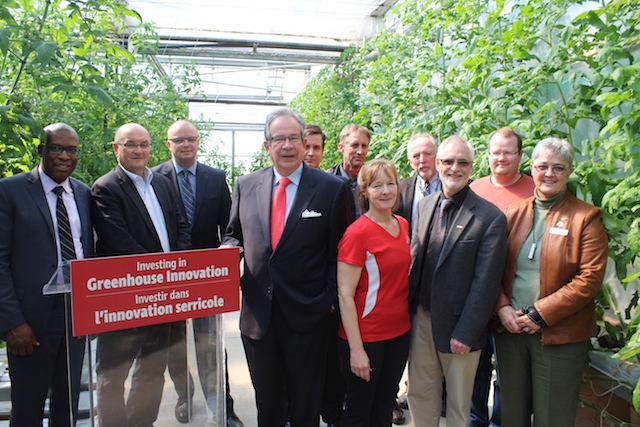
March 24, 2017, Leamington, Ont. – Greenhouse vegetable farmers in Ontario were happy to learn of the new Greenhouse Competitiveness and Innovation Initiative announced yesterday. The new initiative will help farmers compete with neighbouring regions.
“Ontario’s greenhouse vegetable farmers thank Minister Leal and Premier Wynne for announcing this initiative,” says George Gilvesy, chair of Ontario Greenhouse Vegetable Growers (OGVG).
“We look forward to working with the provincial government to ensure the Ontario greenhouse vegetable sector remains competitive into the future by strengthening investment in Ontario, creating local jobs and continuing to provide fresh, healthy produce for Ontarians year-round.”
The $19 million initiative promises to help Ontario greenhouse farmers continue to make a significant contribution toward meeting the Premier’s growth challenge to Agri-food and ensures a secure food supply for Ontarians through the winter months. Sector growth will occur both through the expansion of acreage and by moving toward 12-month production, allowing Ontario growers to retain and expand their market share.
OGVG is responsible for licensing all growers, packers and marketers of Ontario greenhouse tomatoes, cucumbers and peppers. Currently, OGVG has over 200 growers, representing nearly 2900 acres of high-tech hydroponic greenhouse production.
ONTARIO GREENHOUSE VEGETABLE SECTOR BACKGROUNDER
Greenhouse farming is a thriving sector in Ontario’s agricultural landscape that contributes heavily to the Ontario economy, creates jobs and supports healthy living initiatives across the province.
According to Statistics Canada, farmgate value of Ontario greenhouse commodities represented by OGVG has grown from $6.7 million in 1967 to over $820 million in 2005.
Ontario’s greenhouse growers have invested heavily in innovation that increases efficiency and reduce costs by reducing inputs while maintaining a productive crop. In general, greenhouse growers are early adopters of innovation with many operations installing state of the art equipment and implementing novel practices such as:
• Water and nutrient recirculation equipment.
• High tech disinfection systems.
• High efficiency boilers and heat storage facilities.
• Energy/shade curtains to improve heat retention in the winter and shade the crop in the summer.
• Computerized and automated crop management systems based on sensor feedback that allow nutrients, irrigation, heating and cooling to be precisely tailored to the crop’s needs at any point during the day or night.
• Installation of flue gas CO2 units on boilers to effectively capture and use this combustion by-product allowing the crop to benefit from higher CO2 levels during times of high photosynthetic activity.
In this manner, the crop is only provided with the precise inputs it requires at the time when it can most efficiently use them. These improvements focus on reducing crop inputs and maximizing crop efficiency. Reduced crop inputs, whether it be reduced water use, reduced fertilizer use or more directly, reduced fuel consumption, all translate to increased competitiveness.
Print this page
 PHOTO COURTESY OMAFRA
PHOTO COURTESY OMAFRA